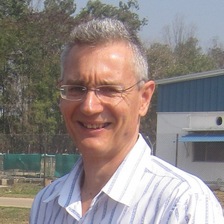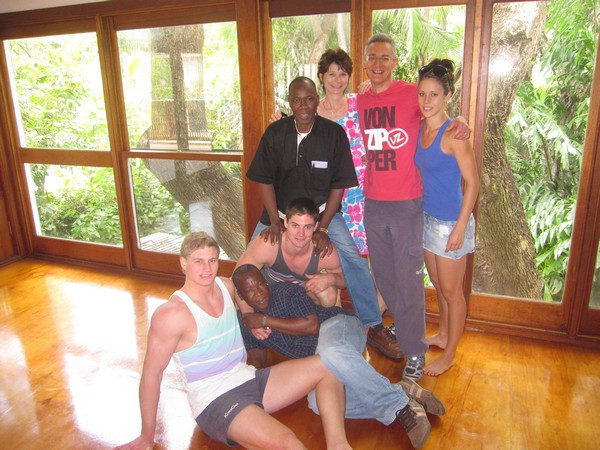Friendship and trust at the heart of sorghum research
…benefits to humanity are the real driver of the work.”
 Andrew Borrell (pictured) is a man who loves his work – a search for a holy grail of sorts for the grain of his choice – sorghum.
Andrew Borrell (pictured) is a man who loves his work – a search for a holy grail of sorts for the grain of his choice – sorghum.
Based at the University of Queensland, Australia, Andrew is co-Principal Investigator with David Jordan for a GCP-funded project developing drought-adapted sorghum for Africa and Australia. And Andrew is passionate not just about the potential of sorghum, but also about the cross-continental relationships that underpin his research team. These friendships, says Andrew, are the glue that hold his team together and make it work better.
The year 2013 was particularly exciting. After almost five years working with African plant breeders to improve genetic material, field trials were up and running at 12 sites across East and West Africa. Fastforward to 2015 and glad tidings for the New Year! Andrew and his team now have preliminary evidence that the drought-tolerant ‘stay-green’ trait enhances grain size and yield in some of the target countries in Africa for which data have already been analysed.
What Andrew hopes to see is more genetic diversity, not just for diversity’s sake but put to use in farmers’ fields to enhance yield during drought. This means more food, fodder and other sorghum by-products such as stems for construction. These benefits to humanity are, he says, the real driver of the work his team does.
So what are the wonders of ‘stay-green’? Waxing lyrical…
The sought-after ‘stay-green’ trait that Andrew and his team are so interested in describes the phenotype – what the plant looks like. It simply means that when drought strikes, sorghum plants with this trait remain leafy and green during the grain-filling period – a critical time when the plant’s water is channelled to developing healthy panicles of grain.
So, what makes these plants remain healthy when others are losing their leaves? Why do they wax while others wane? The answer, says Andrew, is twofold, and is all to do with water supply and demand, and more and less. Firstly, there is some evidence that the roots of the stay-green plants penetrate deeper into the soil, tapping into more water supply. Secondly, plants with the stay-green trait have a smaller leaf canopy which means less water demand by the plant before flowering, leaving more water for grain-filling after flowering.
Staying power and stover are also part of the story. According to Andrew, “Plants with the stay-green trait produce more grain in dry conditions, have stronger stems so they don’t fall over, and often have larger grains. And it’s not just about grain alone: stay-green also improves the quality of the stover left in the field after harvest, which serves as animal feed.”
Another key feature of the stay-green trait in sorghum is that it is not just a fair-weather friend: it works well in wet as well as dry conditions. “All the evidence we’ve got suggests that you get a benefit under tough conditions but very little penalty under good conditions,” says Andrew.
…the process is synergistic and we do something that’s better than any of us could do alone.”
Safari from Down Under to Africa: East and West, and home are all best
For Andrew and his co-Principal Investigator, David Jordan, the GCP project is the first time they have been involved in improving sorghum in Africa. The two scientists work with sorghum improvement teams in six African countries: Mali, Burkina Faso and Niger in the west, and, Ethiopia, Kenya and Sudan in the east. By crossing African and Australian sorghum, the teams have developed the lines now being field-tested in all the six countries.

A sampling of some of stay-green sorghum partnerships in Africa. (1) Asfaw Adugna (Ethiopian Agricultural Research Institute) assessing the genetic diversity of sorghum panicles produced from the GCP collaboration at Melkassa, Ethiopia. (2) Clarisse Barro-Kondombo (Institut de l’environnement et de recherches agricoles, Burkina Faso) and Andrew Borrell (Australia) visiting a lysimeter facility at ICRISAT in Hyderabad, India, as part of GCP training. (3) Clement Kamau (Kenya, left) and Andrew Borrell (Australia, right) visiting the seed store at the Kenya Agricultural Research Institute (KARI) in Katumani, Kenya.
According to Andrew, the collaboration with African scientists is “a bit like a group of friends using science to combat hunger. That’s probably been the biggest advantage of GCP,” adds Andrew. “Bringing people together for something we are all passionate about.”
There’s another collaborative element to the project too. As well as improving and testing plant material, the Australian contingent hosts African scientists on three-week training sessions. “We span a whole range of research topics and techniques,” explains Andrew. “We learn a lot from them too – their local expertise on soil, crops and climate. Hopefully the process is synergistic and we do something that’s better than any of us could do alone.”
Andrew says that working personally with plant breeders from Africa has made all the difference to the project. “Once colleagues from overseas come into your country, you develop real friendships. They know your families, they know what you do, and that’s very important in building relationships and trust that make the whole thing work.”

It wasn’t all work and there was clearly also time to play, as we can see here, Sidi Coulibaly and Niaba Teme from Mali visit the Borrell family in Queensland, Australia.
Golden sunsets, iridescent rainbows and perpetual evergreen partnerships
As Andrew and his team wait to see how their field experiments in Africa turn out, they know that this is not the end of the story. In fact, it is only the beginning. Once tested, the germplasm will provide genetic diversity for future breeding programmes in Africa.
And the research collaboration between Australia and Africa won’t end when GCP funding runs out and GCP sunsets. For example, in addition to the GCP project, David Jordan has secured significant funding from the Bill & Melinda Gates Foundation for another four years’ sorghum research in Ethiopia. Plus, Andrew and Kassahun Banttea, a colleague from Jimma University, have also just been awarded a PEARL grant from the Foundation to assess the sorghum germplasm collection in Ethiopia for drought-adaptation traits.
We wish this ‘stay-evergreen’ team well in their current and future ventures. More sorghum ‘stickability’ and staying power to them! May they find the proverbial pot of gold at the end of the rainbow.
This enchanted rainbow-rings-and-sorghum photo is from Andy Borrell, and, contrary to the magical song, please continue under the rainbow for links to more information.
Links
- Sorghum – Stay-green project | Research Initiative | InfoCentre | Slides | Blogposts
- A 2014 update on the sorghum stay-green project on page 39. Updates from previous years
- Open-access drought phentoyping book, with a chapter on sorghum
- Below are Andy’s slides at the 2013 and 2011 GCP General Research Meetings (GRMs)
- Andy has been a constant star at our GRM poster sessions, winning several awards here, here and here, a mix of both the light & fun and educational & serious awards that have been the hallmarks of our poster sessions.








